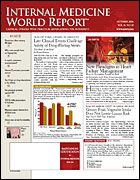Publication
Article
Internal Medicine World Report
The New Electronic Funds Transfer
Author(s):
Dr Rogers is Medical Officer, Office of the Administrator, and Director, Physicians Regulatory Issues Team, Center for Medicare & Medicaid Services, Department of Health and Human Services
Two months ago the Medicare program began to require that all physicians or other providers who were newly enrolling in Medicare or who were filling out an 855 form for other reasons sign up to receive Medicare payments electronically.
Electronic funds transfer (EFT) is a familiar process to most of us; my paychecks from the government have been electronically deposited for years (the emergency department staffing company that I work for continues to send me paper checks). It is definitely the best way to receive a check in my opinion, but for the uninitiated it may cause some anxiety.
Why has Medicare imposed this requirement now? Federal law (specifically 31 USC $3332) requires that as of January 1, 1999, all federal payments, including Medicare payments to providers and suppliers, be made by EFT or direct deposit. CMS (Centers for Medicare & Medicaid Services) is requiring EFT payments for (1) providers and suppliers currently enrolling in the Medicare program, (2) providers and suppliers who are revalidating, and (3) providers and suppliers submitting a CMS-855 change request. Most hospitals and other Part A providers and suppliers are already paid by EFT. There are definite advantages for all providers and suppliers to receive EFT.
What's the benefit to your practice? Payments are directly deposited into your practice's bank account, even if there is a disruption in mail service, as occurred in the aftermath of hurricanes Katrina and Rita. EFT ensures that payments are made to the correct provider or supplier, reduces the threat of identity theft, eliminates delays, and finally, eliminates the administrative cost of replacing lost paper checks. Using EFT also represents a valuable time saver for staff and avoids the hassle associated with going to the bank to deposit Medicare checks.
How will this work for your practice? If you currently receive a paper check, we would encourage you to visit www.cms.hhs.gov/CMSforms and download a copy of the CMS-588 Electronic Funds Transfer Authorization Agreement.
Complete the application, include a voided check (which confirms your account number and bank routing information), and provide an original signature of the responsible party, then send the information to your carrier. Within as little as 2 weeks, you will begin having your Medicare payments deposited directly to your bank account. If you currently receive a paper remittance you may continue to get that in order to balance your payment with your claims submissions or you can elect to receive the remittance advice electronically.
Does EFT give CMS access to your bank account?
CMS is given the ability to directly deposit payment for claims into the account. In the event of a gross administrative error, CMS is allowed to correct its mistake. Otherwise, CMS does not have the ability to access the account and will continue to work with you, as it has in the past, in the event of an overpayment or other payment disputes.
What's the new MREP software? A related new service that you should be aware of, particularly if you work in a large practice, is the Medicare Remit Easy Print (MREP) software. CMS has developed free software, which enables physicians, providers, and suppliers (who bill Medicare carriers, including durable medical equipment regional carriers [DMERCs] and durable medical equipment [DME] Medicare administrative contractors [MACs]), to view, search, and print Health Insurance Portability and Accountability Act (HIPAA) of 1996?compliant 835s from their own computer.
With this software, providers can print their own remittances and export special reports that show coinsurance/ deductible amounts, denied service lines, adjusted service lines, and coordination of benefit claims (ie, claims that were automatically crossed).
If you need access to a HIPAA-compliant 835 or want access to MREP software, contact your carrier or DMERC/DME MAC.
As of June 1, 2006, your carrier or DMERC has no longer been sending both an electronic remittance advice and a paper remittance advice, per CR 4376. MREP software can be used to view your HIPAA-compliant 835 (or electronic remittance).
If you have questions about your options,see SE0627 at www.cms.hhs.gov/MLNMattersArticles/downloads/SE0627.pdf
Remittance advice
As of October 1, 2006, CMS has ended the contingency plan for the remittance advice transaction. Your carriers, fiscal intermediaries, home health intermediaries, DMERCs, and DME MACs will only send HIPPA-compliant remittance advice to electronic receivers. In doing so, Medicare will stop sending electronic remittance advice in any version other than the standard HIPAA version (835 version 004010A1), or in any other format.
For more information on ending the contingency for remittance advice, see SE0646 at www.cms.hhs.gov/MLNMattersArticles/downloads/SE0646.pdf
The Physicians Regulatory Issues team at CMS exists to advocate for physicians who care for Medicare beneficiaries. I would love to hear your ideas about how Medicare could work better for you. william.rogers@cms.hhs.gov





